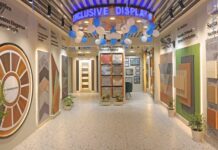
Earlier this year Soi was awarded a residency at the Mondriaan Foundation’s Pompgemaal Atelier in Huisduinen. The cold winter light of Northern Netherlands inspired Soi to use silverpoint, marking the return of the landscape to his oeuvre. The process of silverpoint is irreversible and forces the hand to respond to the vista in a very particular way. The artist approaches the landscape as a motif, a tradition that traces its lineage to that of landscape painting from Santiniketan in Bengal.
Moving away from the landscapes are the larger canvases in which a multiplicity of subject matter creates a narrative of flux. In the two canvases, Still- Life and September, Soi brings together different registers of image, scale and narrative intent. The larger, monumental imagery, blocked out in chunks of color and filled in with painted lines, is reminiscent of the artist’s earlier works and points to the works of the Progressives. These images are activated by their proximity to the smaller, iconic images that proliferate on the canvas, wrought crisplyin miniature format. What this juxtaposition achieves is an articulation of the artist’s gaze that looks both to the media as well as his immediate surroundings in search of narrative ground.
In the work Ashraf Ghani outlines his Vision, the artist creates an atmospheric rendering in charcoal upon canvas of the current Afghan President surrounded by written excerpts from a speech Ghani delivered in the US last year. In March 2015 the artist was a Smithsonian Scholar at the Sackler and Freer Galleries in Washington DC where he was studying ancient Islamic paintings. While in Washington Soi also attended lectures at think-tanks such as the Council of Foreign Relations, The Brookings Institution, and the Carnegie to name a few. An understanding of the currently disturbed geopolitical reality of the regions, whose exquisite paintings Soi was researching, aided Soi in making a link between the miniature format and his use of political imagery.
Lastly, The Bauhaus inspired display system points to the High Modernism that has in part ignited the thinking that lies behind the new body of work that is on display here.
Praneet Soi (Kolkata, 1971) completed his BFA and MFA in painting at the Faculty of Fine Arts, MSU Baroda, following which he worked in the advertising industry in New Delhi. He went on to doing his second masters from University of California at San Diego on a scholarship, and then moved to the Netherlands in 2002 to attend the Rijksakademie van beeldende Kunsten, for a two-year international residency program for artists. Soi has since divided his time between Amsterdam and Kolkata. This movement between two cities impacts his practice which develops out of “patterns that emerge from an investigation of his extended social and economic landscape.”
In 2011 he was one of 4 artists representing India at the Indian Pavilion in Venice where he created a site-specific drawing installation. In 2014 Soi was artist in residence at Stiftung Laurenz Haus in Basel. In the same year he was granted a research fellowship at the Smithsonian Institute in Washington D.C. for studying illuminated manuscripts the Sackler and Freer Galleries. In 2016 Soi will be participating in the Kochi Muziris Biennale and in 2017 unveiling a solo exhibition at the Bhau Daji Lad Museum in Mumbai.
05 October – 15 October 2016
Vadehra Art Gallery| D-53, Defence Colony, New Delhi 110024
Corporate Comm India(CCI Newswie)


























